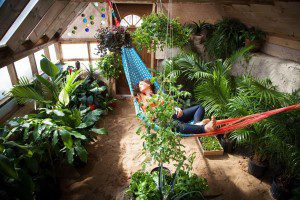Contributing Writer for Wake Up World
It’s no secret that food security is becoming a critical issue around the world. With drought, economic instability, erratic weather and interruptions in transportation a very real threat, it really doesn’t take much to have the food supply disrupted. We’re certainly not immune to these effects in the West, especially since we rely heavily on corporate farming and mega supermarkets. Add to this population growth and the ecological toll of conventional, large-scale food production, and we have a seriously unsustainable system in place — one that could topple at any time. The drought in California, USA is a perfect example, where entire almond orchards and other crops have been laid to dust.
But it’s not all doom and gloom. As the famous proverb says: “Necessity is the mother of invention.” Taking this proverb and running with it, a team of innovators from Quebec, Canada have developed an eco-friendly and exceptionally cost-effective solution to our food woes — the greenhouse of the future.
[pro_ad_display_adzone id=”110028″]
Inspiration taking root
During a certification course at Earthship Academy, a seed was planted in the mind of Francis Gendron for a different kind of greenhouse. A turning point, Gendron realized our current food system is no longer sustainable and that we need creative solutions — quickly.
“I started to think about all the implications that this could have: help people become more resilient, autonomous and environmentally friendly. I remembered reading that the largest consumption of energy in colder countries came from the importation of food and, obviously, from domestic heating. At this time, our food travels thousands of kilometers before meeting our mouths. It is great to have access to exotic products, but in the case of a technologic or economic crisis, a war, a natural disaster or anything else that quickly spreads across borders, it is possible that we will no longer have access to any!”
Combining the principles of Earthships, aquaponics and passive solar greenhouses, Gendron — along with friends, Christian Désilets and Curt Close — designed and built a radically different food growing system. Not wholly surprising, they christened it The Greenhouse of the Future.
Vision and structure
Largely utilizing easy to find recycled materials, the team set out to build a greenhouse that would grow organic produce in any climate, while also providing a space for people to connect with nature and relax in warmth during the frigid winter months. Their main focus was to create a micro-climate for producing an abundance of food with minimal energy usage and low construction cost.
 How did they do it?
How did they do it?
The greenhouse is designed so that it’s partially dug into the ground to take advantage of the earth’s insulating properties. Recycled tires are filled with soil and used for the walls to further help regulate the indoor temperature. When prepared in this manner, the tires absorb heat during the day and then release it at night. In addition, earth tubes are used throughout to heat the interior during the winter and cool it during warmer weather. Solar panels can be installed as well for a completely off-grid structure.
Positioning of the greenhouse is crucial. In the northern hemisphere, the clear polycarbonate frontside faces southward to make the most of the sunlight. Situating the greenhouse in this way also puts into service the insulated roof — during the winter months, the roof reflects light towards the plants, whereas in summertime, it helps to protect the crops from extreme temperatures.
What’s more, the greenhouse utilizes a passive rainwater collection system. Gutters in the roof funnel rain into collection barrels within the greenhouse. Not only does this provide water for the plants, but also increases thermal mass, furthering the regulation of temperature.
Aesthetic features include attractive glass bricks pieced together from recycled bottles, cedar siding and a DIY polycarbonate door.
And yet, the real beauty of the structure lies within its ingenious design that’s both eco-friendly and inexpensive to build. At the same time, the greenhouse offers a very doable solution for food self-sufficiency. As Curt Close points out:
“The greenhouse of the future project is a breakthrough for the S.A.F.E (Sustainable Autonomy/Abundance for Everyone) movement because it synthesizes many of the best resilient and passive sustainable technology. It allows anyone to understand and apply them in their own lives, but also encourages people to keep innovating so that together, we can create a climate FOR change! Transforming the garbage of the past in the beauty and abundance of the future is not easy, but what else is more important and better to do?”
The Greenhouse of The Future ~ official trailer
Article sources:
- “Greenhouse of the Future — Abundance and Energy Autonomy” Francis Gendron, Christian Désilets, Curt Close, Frédéric Wiper, Marie-Soleil Martel.
- http://www.solutionera.com
- www.greenhouseofthefuture.com
Previous articles by Carolanne:
- First U.S. City Produces More Electricity Than It Uses — With 100% Renewable Technology
- Dry Skin Brushing Can Strengthen Immunity, Spark Detoxification and Reverse Aging
- Cannabis Dissolves Cancerous Tumor in Young Infant, Deemed ‘Miracle Baby’ by Physician
- Report Finds Cancer Deaths Have Doubled in Argentina’s GMO Growing Regions
- Is Mold Making You Sick?
- Why Everyone Should be Eating More Hempseed
- Autistic Boy with Higher IQ Than Einstein Discovers Gift After Removal from State-Run Therapy
- Enhance Spiritual, Mental and Physical Well-being with a Pineal Gland Detox
- DIY $2 Self-Watering Garden Bed – Grow Produce Easily, Even in the Toughest Conditions
- How Being Too Clean Can Lead to Cancer, Multiple Sclerosis, Celiac Disease and More
[pro_ad_display_adzone id=”110025″]
[pro_ad_display_adzone id=”110027″]







